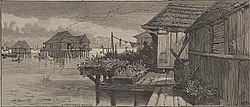Saint Malo
San Maló (Spanish) | |
|---|---|
 The settlement as it appeared in Harper's Weekly, 1883. | |
| Coordinates: 29°52′41″N 89°35′49″W / 29.87806°N 89.59694°W | |
| Country | United States |
| State | Louisiana |
| Parish | St. Bernard Parish |
| Establishment | c.1763 |
| Destruction | September 29, 1915 |
| Named for | Juan San Maló |
| Time zone | UTC−6 (Central) |
| • Summer (DST) | UTC−5 (Central) |
Saint Malo (Spanish: San Maló [samaˈlo]) was a small fishing village that existed along the shore of Lake Borgne in St. Bernard Parish, Louisiana as early as the mid-eighteenth century until it was destroyed by the 1915 New Orleans hurricane.[1] Located along Bayou Saint Malo, about 6 miles (9.7 km) east of the Isleño fishing village of Shell Beach, it was the first permanent settlement of Filipinos and perhaps the first Asian-American settlement in the United States.[2][3][4][5]
The exact date of the establishment of Saint Malo is disputed.[6][4] The settlement may have been formed as early as 1763 or 1765 by Filipino deserters and escaped slaves of the Spanish Manila galleon trade.[7][8][9][10] The members of the community were commonly referred to as Manila men, or Manilamen, and later Tagalas.[2]
Filipino Americans residing in the region (referred to as "Manilamen" on the account of Manila being the capital of the Philippines) were recruited by local pirate Jean Lafitte to join his "Baratarians", a group of privately recruited soldiers serving under the American forces under the command of Andrew Jackson, in the defense of New Orleans. They played a decisive role in securing the American victory, firing barrage after barrage of well-aimed artillery fire.[4]
- ^ Cite error: The named reference
SIwas invoked but never defined (see the help page). - ^ a b Welch, Michael Patrick (27 October 2014). "NOLA Filipino History Stretches for Centuries". New Orleans & Me. New Orleans: WWNO. Retrieved 4 July 2019.
- ^ Randy Gonzales (2019-09-14). "Unveiling of St. Malo Historical Marker". Filipino La. Retrieved 2020-05-23.
- ^ a b c Hinton, Matthew (2019-10-23). "From Manila to the Marigny: How Philippine pioneers left a mark at the 'end of world' in New Orleans". Very Local New Orleans.
- ^ "Filipino American History Month Resolution". FANHS National. Retrieved 2020-05-23.
- ^ Namur, Amy (2019-11-26). "Louisiana Honors First Filipino Settlement". Asia Matters for America.
- ^ Catholic Church. United States Conference of Catholic Bishops (December 2001). Asian and Pacific Presence: Harmony in Faith. United States Conference of Catholic Bishops. p. 8. ISBN 978-1-57455-449-6.
- ^ Pang, Valerie Ooka; Cheng, Li-Rong Lilly (1999). Struggling to be heard: the Unmet Needs of Asian Pacific American Children. NetLibrary, Inc. p. 287. ISBN 0-585-07571-9. OCLC 1053003694.
- ^ Holt, Thomas Cleveland; Green, Laurie B.; Wilson, Charles Reagan (2013-10-21). "Pacific Worlds and the South". The New Encyclopedia of Southern Culture: Race. 24: 120. ISBN 978-1469607245.
- ^ Westbrook, Laura. "Mabuhay Pilipino! (Long Life!): Filipino Culture in Southeast Louisiana". Folklife in Louisiana. Retrieved 2020-05-23.

